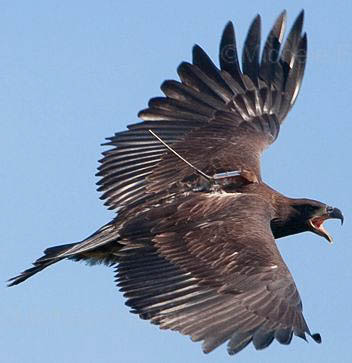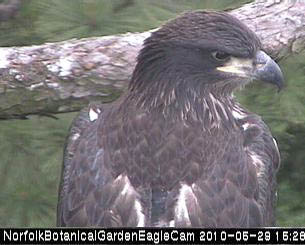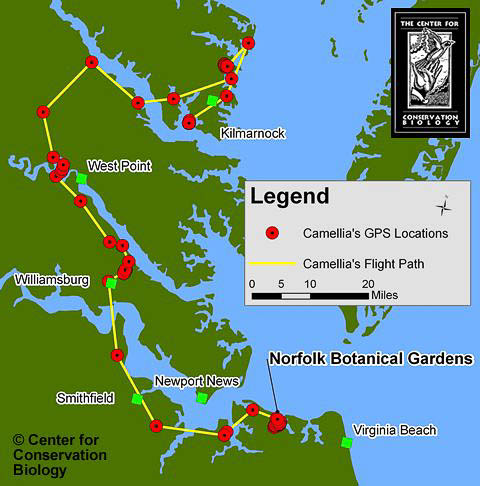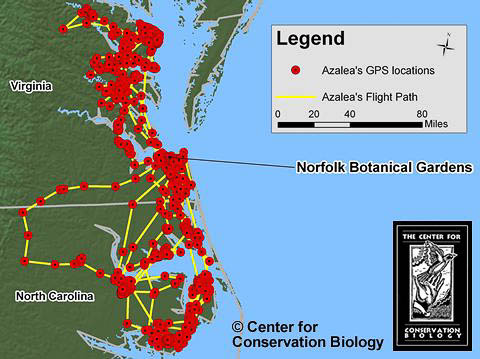2010 EagleTrak transmittered eagle, Camellia
Are the Eaglets Male or Female?
May 7, 2010Sticking to Catfish Diet
May 9, 2010
Written by Elizabeth Mojica and Carla Schneider
May 7, 2010

Camellia (banded NC), June 2, 2010 (12-weeks or 84-days old). Photo by Shelly Fowler.
Over the past 5 years, the Center for Conservation Biology (CCB) has tracked bald eagles using satellite transmitters to investigate movement patterns, shoreline use, communal roosting behavior and survival rates.
CCB began project EagleTrak in 2009, initiating the first ever satellite tracking effort on eagles from the southern Chesapeake Bay region. On May 5, 2010 CCB Raptor Biologist, Libby Mojica, fitted this year’s EagleTrak eaglet (male, banded NC, named Camellia, FWS band #679-01370, hatched March 11), with a GPS-PTT solar-powered satellite transmitter on May 5. Weighing 70 grams, each specialized transmitter is custom-fitted on an eagle’s back with a backpack-style Teflon harness. The life expectancy of the battery in the transmitter is 3 years, and the backpack is expected to fall off around the same time, as the harness material biodegrades.

Close-up of Camellia sitting in front of the nest camera at NBG, captured by Reese Lukei 29 May 2010. Photo by Reese Lukei.
Wildlife research subjects are not typically named, but it is customary for individuals involved in tracking projects to be given names for ease of communication and identification (both EagleTrak eagles from Norfolk Botanical Garden (NBG) have been given botanical names). Camellia fledged from his natal nest tree on May 27, and left the Norfolk Botanical Garden area on July 13. His most recent transmitter location was Weems, VA on the Rappahannock River.

Map of Camellia’s travels since fledging May 31, 2010. Photo by the Center for Conservation Biology.
The Center for Conservation Biology provides the personnel, equipment and supplies to fit the eagles and collects and monitors the tracking data. The satellite company, Argos, transmits location data every 3 days to CCB. All locations for each tracked eagle are posted at www.wildlifetracking.org on a webpage specific to each individual bird. CCB Research Associate, Reese Lukei Jr, posts detailed data, photos and commentary to the EagleTrak blog (eagletrak.wmblogs.net) to help to interpret the data and behavior of the eagles as they travel.
CCB devised the EagleTrak project to give insight into the behavior of the southern Chesapeake’s bald eagles. Fledgling bald eagles typically remain within their natal territory for a period that ranges from weeks to months after they are flighted. The birds then disperse widely before settling down in social groups typically around prime foraging areas. Of particular interest for birds dispersing from NBG, is how much these birds interact with populations in the sounds of North Carolina. Azalea (female NBG eagle hatched & banded HH in 2009), the initial subject of EagleTrak, has transmitted location data to CCB and an eager public for over a year. She has spent the greater part of that time ranging in North Carolina, frequently visiting the catfish ponds at the Tidewater Research Station near Plymouth, where there is a known communal roost of young eagles.

Azalea, banded HH in May 2009 at Norfolk Botanical Garden (NBG), has traveled more than 2500 miles, all recorded via GPS positions sent from the satellite transmitter she wears. Photo by the Center for Conservation Biology.
Funding for each transmitter and its corresponding satellite data collection is estimated at $10,000 over 3 years and comes almost exclusively from the general public. Please visit the website www.wildlifetracking.org to ‘adopt’ Camellia and support the program. Adoptive parents receive a package that includes a photo of the adopted eagle. All donations are sent to CCB and used to pay for the satellite fees for the bird adopted.

Three bald eagles hatched at Norfolk Botanical Garden (NBG) in 2010 – Identified by resight band in order, left to right, NC ‘Camellia’ (#679-01370, hatch March 11), ND (#679-01371, hatch March 13), NE (#679-01372, hatch March 14). Photo by Carla Schneider.
Project Partners: The Center for Conservation Biology (CCB), Norfolk Botanical Garden (NBG), Virginia Department of Game & Inland Fisheries (VDGIF), and Nuckols Tree Care, Inc.
Project Sponsors: 2010 EagleTrak eagle, Camellia, has more than 61 adoptive parents & counting view the list and chose to help to support the cost of Camellia’s satellite transmitter here




